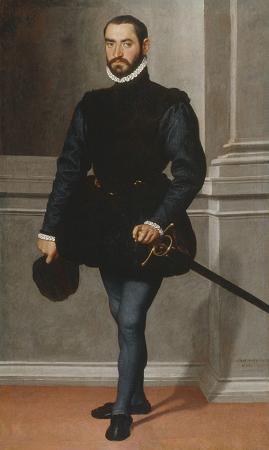
Giovanni Battista Moroni. Giovanni Battista Moroni was an Italian painter of the Late Renaissance period.
He also is called, Giambattista Moroni. Best known for his elegantly realistic portraits of the local nobility and clergy, he is considered one of the great portrait painters of sixteenth century Italy.
Moroni was the son of architect Andrea Moroni. He trained under Alessandro Bonvicino Il Moretto in Brescia, where he was the main studio assistant during the 1540s, and worked in Trento, Bergamo and his home town of Albino, near Bergamo, where he was born and died.
His two short periods in Trento coincided with the first two sessions of the Council of Trent, 1546-48 and 1551-53. On both occasions Moroni painted a number of religious works as well as the series of portraits for which he is remembered.
During his stay in Trento he also made contact with Titian and the Count-Bishop, Cristoforo Madruzzo, whose own portrait is by Titian, but for whom Moroni painted portraits of Madruzzo's sons. There were nineteenth-century claims that he was trained by Titian at Trento, however, it is improbable that he ever ventured to the Venetian's studio for long, if at all. Moroni's period as the fashionable portraitist of Bergamo, nowhere documented, but in the inscribed dates of his portraits, is unexpectedly condensed, spanning only the years ca. 1557-62, after which Bergamo was convulsed in internecine strife an
He also is called, Giambattista Moroni. Best known for his elegantly realistic portraits of the local nobility and clergy, he is considered one of the great portrait painters of sixteenth century Italy.
Moroni was the son of architect Andrea Moroni. He trained under Alessandro Bonvicino Il Moretto in Brescia, where he was the main studio assistant during the 1540s, and worked in Trento, Bergamo and his home town of Albino, near Bergamo, where he was born and died.
His two short periods in Trento coincided with the first two sessions of the Council of Trent, 1546-48 and 1551-53. On both occasions Moroni painted a number of religious works as well as the series of portraits for which he is remembered.
During his stay in Trento he also made contact with Titian and the Count-Bishop, Cristoforo Madruzzo, whose own portrait is by Titian, but for whom Moroni painted portraits of Madruzzo's sons. There were nineteenth-century claims that he was trained by Titian at Trento, however, it is improbable that he ever ventured to the Venetian's studio for long, if at all. Moroni's period as the fashionable portraitist of Bergamo, nowhere documented, but in the inscribed dates of his portraits, is unexpectedly condensed, spanning only the years ca. 1557-62, after which Bergamo was convulsed in internecine strife an
Wikipedia ...